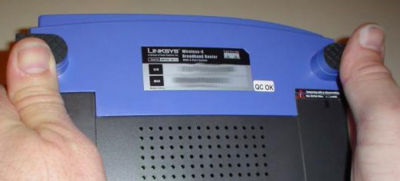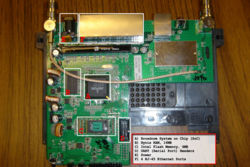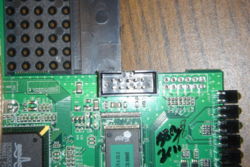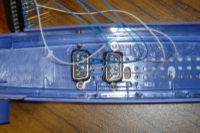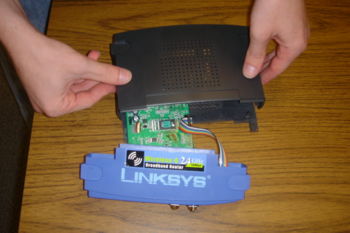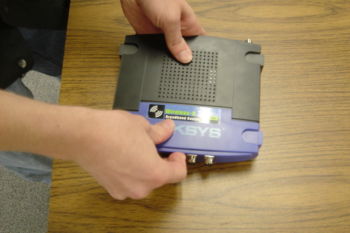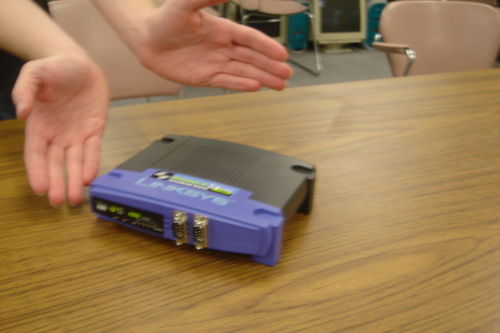Modify the Linksys hardware
Summary
This will walk through adding hardware to a Linksys WRT54GL wireless router that will take advantage of existing leads on the PCB for two UART connections, which will be exposed as DB9 connectors mounted to the faceplate of the router. These connections can be used to communicate with the serial console for XINU and also to interact with the Common Firmware Environment's command line interface. Gaining direct access to CFE is a key step towards being able to run XINU on the router.
Before Starting
Parts List
| Quantity | Part Name | Details | Part / Model Number | Price |
|---|---|---|---|---|
| 1 | LinkSys WRT54GL Router | 802.11b/g wireless broadband router | Linksys WRT54GL | ~$65.00 |
| 1 | Ribbon cable | 28 AWG, 10 conductor, 25' | Jameco 643508CM | $4.99 |
| 1 | IDC socket connector | 0.1”, 10 conductor | Jameco 32491CM | $0.25 |
| 1 | IDC shrouded header | 0.1”, 10 conductor | Jameco 67811CM | $0.33 |
| 1 | RS232 Transmitter/Receiver | IC 2DVR/2RCVR RS232 5V 20-DIP | DigiKey MAX233CPP-ND | $7.45 |
| 1 | DB9 Female | 22AWG,SOLDER CUP | Jameco 15771CM | $0.59 |
| 1 | DB9 Male | 22AWG,SOLDER CUP | Jameco 15747CM | $0.59 |
(We provide this parts list as a data point; we offer no guarantees about current prices, and it is not our intent to endorse any particular vendor.)
Tools List
- Soldering Iron
- Dremel tool (for cutting holes in plastic case)
- Multimeter, or some other way of checking for proper connections
Steps to Modify the Hardware
Task One: Open the Router
There are no screws or tools needed to open the router, just pop open the front with your thumbs as shown in the picture. Some nice illustrated opening instructions can be found for a more detailed explanation of this step
DO NOTE: This is where the warranty on the router is voided!
Task Two: Attach the Serial Header
Once the PCB has been removed from the case, locate the serial header holes provided by LinkSys. This would be a grid of 10 holes (5x2) located on the bottom-right corner of the board when the antennae stubs are on top (see the top-down photo for clarification). These ten holes hold all of the input and output for the two serial interfaces--UART0, and UART1--on the device.
Now, we could just solder wires right onto these holes, but a by placing a nice 10-pin header on the board we can easily attach and detach a 10 connection cable. This is where you will use your soldering iron to solder the IDC shrouded header onto the board.
This will be the only soldering required for the LinkSys PCB. The rest of the work will be done wiring the MAX233A transceiver and the DB9 connectors correctly and then the finished product just has to be plugged it into this header.
Task Three: Wire Serial Header to MAX233A
Using information on the Wiring page, make the connections from the IDC shrouded header to the MAX233A RS232 Transmitter/Receiver chip using your soldering iron. As you can see from the Build Pictures page, we did this with the ribbon cable from our parts list. The IDC socket connector goes on one end of the cable, and the correct connections are made to the RS232 Transmitter/Receiver on the other. Because we will be mounting our DB9 connectors to the front of the case, this will allow for easy disconnection and opening of the case. In terms of cable length, try and decide where you are going to mount the MAX233A on the outer case so you can estimate correctly.
Be sure to test all of your connections thoroughly before proceeding.
Task Four: Wire the DB9 Connectors to the MAX233A
For the following connections, you are going to use the soldering iron and either chopped up portions of the ribbon cable or some other wire (which would probably be more convenient).
Checking the wiring diagram again, note that there are several loopback connections per DB9 connector in order to fake RS232 hardware flow control compliance. It would be a good idea to get these out of the way first. Then, make the connections required from the RS232 Transmitter/Receiver to the DB9 connectors, remembering to leave enough slack for where you plan on mounting the MAX233A and the connectors.
Again, before mounting anything, test that all connections correspond to the diagram.
Task Five: Mount DB9 Connectors to the Router Faceplate
Using your trusty dremel cut a few DB9 shaped holes in the plastic casing of the router. There are several options for placement; we chose the front so that multiple routers would still be stackable. The picture at right shows the placement of our connectors with wires attached. The fit is quite tight; you may wish to consider only installing one jack (you only need port 0 to communicate with the router, your plans may not call for using the second serial port) or installing them horizontally instead of vertically.
Using either epoxy or mounting screws (I believe we used a combination of both, as one of our jacks could not fit a hole for a screw), secure the connectors to the case.
Following the theme, now would be a good time to do a final test on all connections, because next we are closing things up.
Task Six: Close the Router
This final task is best described in photos:
Task Seven: Rejoice
What to do next?
If you have OpenWRT installed, the first thing to do is to connect UART0 to a computer and follow the next HOWTO on using a PC to connect to a modified router.
